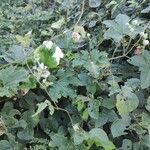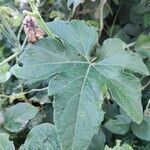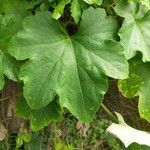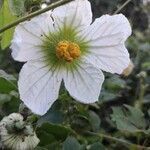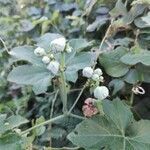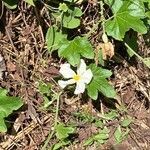Dioecious, perennial herb. Stems annual, prostrate or climbing, up to 10 m long. Leaves outline broadly ovate, cordate, up to 190 x 215 mm, dark green and ± scabrid above, paler and finely, shortly hairy below; palmately 5-lobed; lobes shallow to deep, ovate to elliptic, coarsely sinuate-dentate, often lobulate, central lobe largest; glands prominent, patent; petioles 10-120 mm long. Flowers white with green veins, fragrant. Male flowers racemose; peduncle 10-200 mm long; pedicels 3-50 mm long; receptacle tube 9-17 mm long, obconic below, expanded above; lobes 3-6 mm long, ± lanceolate, glandular; petals 25-55 mm long, obovate. Female flowers: peduncles 15-85 mm long. Flowering time Dec.-Aug. Fruit subglobose, 70-110 x 60-100 mm, smooth, deep green with paler spots and patches; stalk 25-100 mm long, stout. Seeds oblong, 8.5-11.5 mm long, base subtruncate, emarginate, apex ± narrowed, faces with 2, flat, submarginal ridges.
A herb. It is a climber in the pumpkin family. It can climb 10 m high. The stems are angled and nearly smooth. The leaves are 5-15 cm long. They are leathery and rough to touch. They have 5 lobes. The leaf stalk has 2 horn like processes near the base. The male flowers are in groups and white. They are 10-15 cm across. The female flowers occur singly. The fruit is oval and hard. They are 7-11 cm long by 6-10 cm wide. It has a pattern of green and yellow.
Prostrate or scandent perennial herb, usually dioecious (male and female flowers on different plants). Glands at apex of petiole prominent, patent, inserted just below base of leaf lamina. Male flowers usually racemose. Flowers white with green veins.
Dioecious, glabrescent, perennial climber to 10 m. Leaves palmate with coarsely toothed lobes. Flowers axillary, female solitary, male racemose. Fruits subglobose, mottled green.
